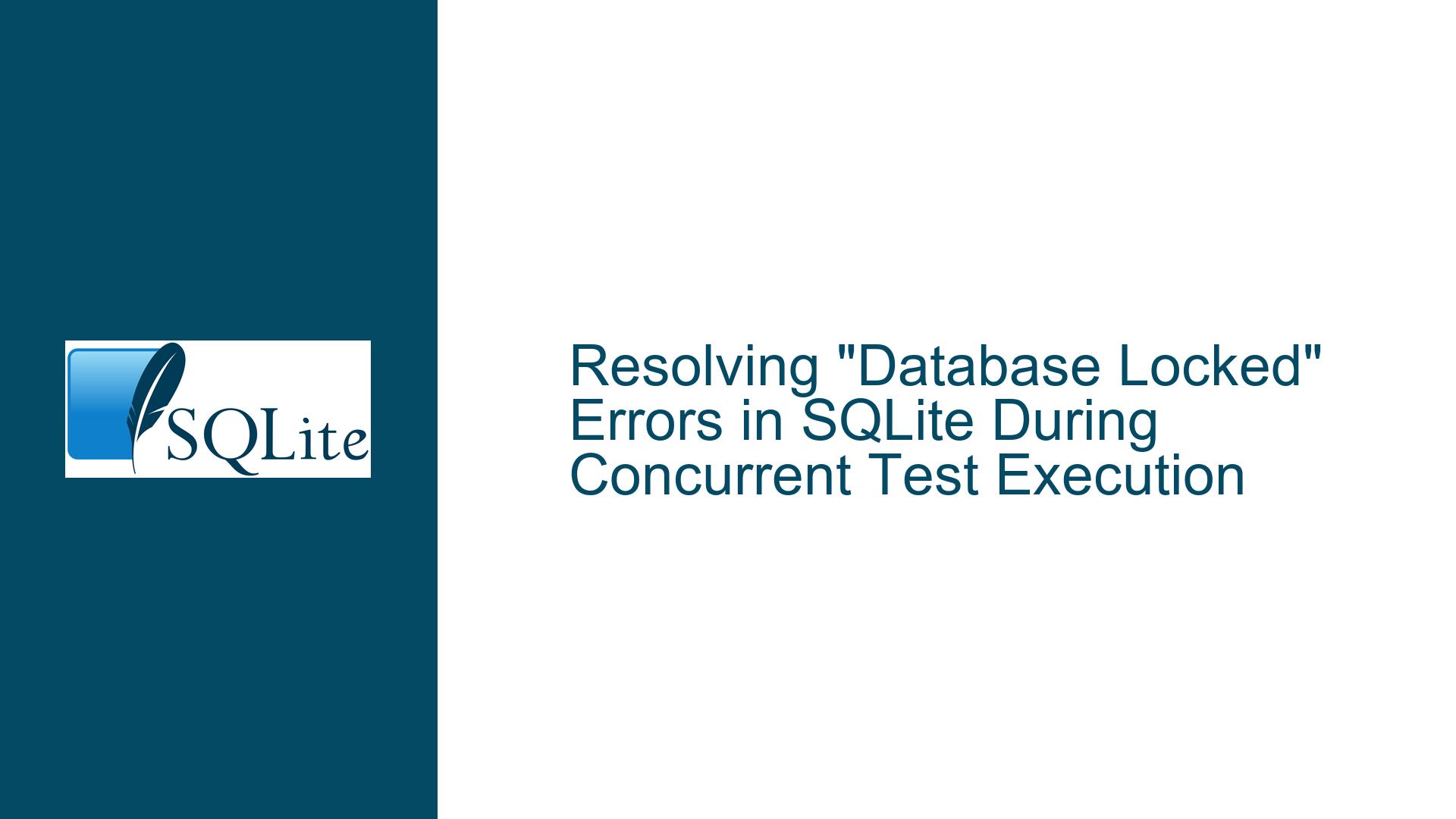Resolving “Database Locked” Errors in SQLite During Concurrent Test Execution
Issue Overview: Understanding SQLite Database Locking During Multi-Test Execution
When working with SQLite in Python-driven test environments, a common challenge arises when multiple tests interact with the same database file. The specific issue described involves a test that performs an INSERT, a SELECT using a LIKE clause, and a subsequent DELETE of the inserted row. This test succeeds when executed in isolation or as the first test in the suite but fails with a "Database locked" error when run after other tests. The error disappears if the explicit con.commit() call is removed or if cursors are opened and closed within each database interaction method.
SQLite employs a locking mechanism to ensure data integrity during concurrent operations. When a write operation (e.g., INSERT, UPDATE, DELETE) is initiated, SQLite acquires a RESERVED lock, which allows other processes to read the database but prevents concurrent writes. Upon committing the transaction (via con.commit()), the lock is elevated to an EXCLUSIVE lock briefly to finalize changes. If a transaction remains uncommitted or improperly managed, the lock may persist, blocking subsequent operations.
The crux of the problem lies in the interplay between transaction boundaries, cursor lifecycle management, and the Python SQLite driver’s behavior. The test suite’s failure under specific execution orders suggests that residual locks or uncommitted transactions from prior tests are interfering with subsequent operations.
Possible Causes: Transaction Mismanagement, Cursor Leaks, and Driver Assumptions
1. Implicit Transaction Handling by the Python SQLite Driver
SQLite operates in autocommit mode by default, where each SQL statement is treated as a separate transaction. However, the Python sqlite3 driver overrides this behavior: it implicitly opens a transaction when a Data Manipulation Language (DML) statement (e.g., INSERT) is executed and waits for an explicit commit() or rollback(). If a test method invokes con.commit(), it finalizes the transaction, releasing the lock. If con.commit() is omitted, the transaction remains open, holding the RESERVED lock indefinitely.
The driver’s assumption that the developer will manually manage transactions can lead to conflicts. For example, if a test performs an INSERT without committing, the RESERVED lock persists, blocking other tests that attempt to write to the database.
2. Cursor Lifecycle Mismanagement
Cursors in SQLite are conduits for executing queries and fetching results. While closing cursors is not strictly required (the Python driver closes them automatically when garbage-collected), lingering cursors can maintain references to outdated database states or retain locks. If a cursor is not closed after a SELECT operation, it may hold a SHARED lock, allowing reads but blocking writes.
In the described scenario, the test that fails when not run first may inherit an open cursor from a prior test, preventing the DELETE operation from acquiring the necessary lock. The resolution—opening and closing cursors per method—eliminates this risk by ensuring no cursors outlive their transactional context.
3. Concurrency and Test Isolation Deficiencies
Test suites often execute tests sequentially, but poor isolation between tests can result in shared database connections or overlapping transactions. If two tests share the same connection object, a transaction left open by one test will directly affect the other. Even with separate connections, SQLite’s file-based locking means that concurrent write attempts from different connections will collide.
Troubleshooting Steps, Solutions & Fixes: Ensuring Atomic Transactions and Cursor Hygiene
Step 1: Enforce Explicit Transaction Boundaries
Problem: Relying on the driver’s implicit transaction management can leave transactions open.
Solution: Use a context manager to enforce atomic transactions:
with con: # Automatically commits or rolls back
con.execute("INSERT INTO table (...) VALUES (...);")
This ensures that the transaction is committed upon exiting the with block, even if an exception occurs. Replace all manual con.commit() calls with this pattern to avoid dangling transactions.
Step 2: Isolate Cursors Within Short-Lived Contexts
Problem: Long-lived cursors may retain locks or references to outdated data.
Solution: Open and close cursors within narrowly scoped blocks:
def execute_query(con, query, params=None):
with con:
cur = con.cursor()
cur.execute(query, params or ())
return cur.fetchall()
The with con block ensures the transaction is committed, and the cursor (cur) is closed when the block exits.
Step 3: Configure Driver to Use Autocommit Mode
Problem: The driver’s implicit transaction management conflicts with SQLite’s default autocommit.
Solution: Disable implicit transactions by setting isolation_level=None when connecting:
con = sqlite3.connect("test.db", isolation_level=None)
This forces the driver to honor SQLite’s autocommit behavior, executing each statement as a standalone transaction. Use this with caution, as it requires manual BEGIN statements for multi-statement transactions.
Step 4: Enable Write-Ahead Logging (WAL) for Concurrent Access
Problem: SQLite’s default journaling mode (DELETE) allows only one writer at a time.
Solution: Enable WAL mode to allow concurrent reads and writes:
con.execute("PRAGMA journal_mode=WAL;")
WAL mode decouples reads from writes, reducing contention. However, this does not eliminate the need for proper transaction management.
Step 5: Isolate Tests with Separate Connections or In-Memory Databases
Problem: Tests sharing a connection or database file interfere with each other.
Solution:
- Use an in-memory database for testing:
con = sqlite3.connect(":memory:") - For file-based databases, create a new connection per test and ensure teardown logic closes connections:
def setUp(self): self.con = sqlite3.connect("test.db") def tearDown(self): self.con.close()
Step 6: Analyze Locking State with Diagnostic Queries
Problem: Uncertainty about which process holds the lock.
Solution: Query SQLite’s pragma to diagnose locks:
cur = con.cursor()
cur.execute("PRAGMA database_list;")
for row in cur.fetchall():
print(f"Database {row[1]} is in journal mode {row[3]}")
Additionally, inspect the SQLite error message for the specific lock type (e.g., SQLITE_BUSY indicates a RESERVED lock).
Step 7: Implement Retry Logic for Concurrent Writes
Problem: Transient locks due to overlapping write attempts.
Solution: Use a retry decorator for database operations:
import time
from functools import wraps
def retry_on_locked(max_retries=3, delay=0.1):
def decorator(func):
@wraps(func)
def wrapper(*args, **kwargs):
retries = 0
while retries < max_retries:
try:
return func(*args, **kwargs)
except sqlite3.OperationalError as e:
if "locked" in str(e):
retries += 1
time.sleep(delay)
else:
raise
raise sqlite3.OperationalError("Max retries exceeded")
return wrapper
return decorator
@retry_on_locked()
def delete_row(con, row_id):
with con:
con.execute("DELETE FROM table WHERE id = ?;", (row_id,))
Step 8: Audit Test Suite for Hidden Dependencies
Problem: Tests relying on shared state (e.g., database rows) create race conditions.
Solution:
- Reset the database state before each test:
def setUp(self): self.con = sqlite3.connect("test.db") self.con.execute("DELETE FROM table;") self.con.commit() - Use transactional rollbacks instead of commits in tests to avoid persistent changes:
def test_insert(self): try: self.con.execute("INSERT ...") # Do assertions finally: self.con.rollback() # Undo changes
Step 9: Profile Database Activity with Debugging Tools
Problem: Difficulty visualizing transaction and lock states.
Solution:
- Use the
sqlite3command-line shell to monitor locks:sqlite3 test.db "PRAGMA lock_status;" - Enable Python driver debugging to log SQL statements:
import logging logging.basicConfig(level=logging.DEBUG)
By systematically addressing transaction boundaries, cursor lifecycle, and test isolation, developers can eliminate "Database locked" errors and ensure robust SQLite integration in test suites.






